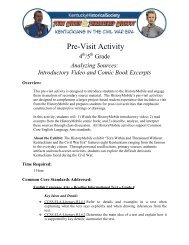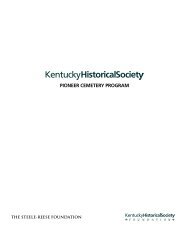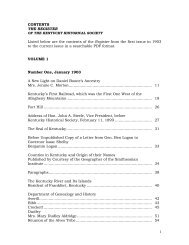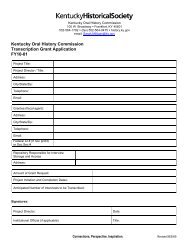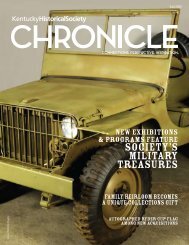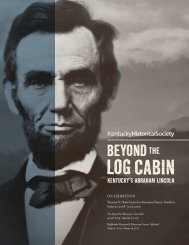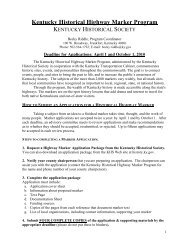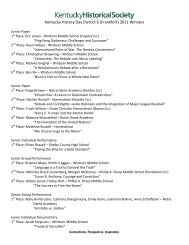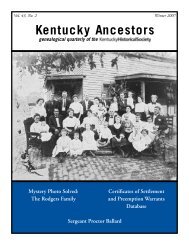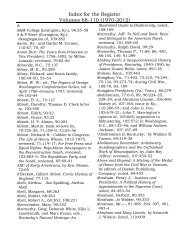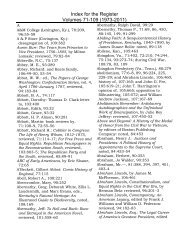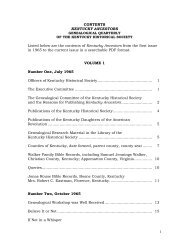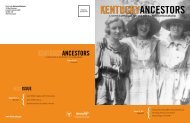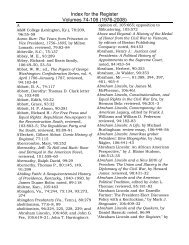Kentucky Ancestors, Volume 46, Number 3 - Kentucky Historical ...
Kentucky Ancestors, Volume 46, Number 3 - Kentucky Historical ...
Kentucky Ancestors, Volume 46, Number 3 - Kentucky Historical ...
Create successful ePaper yourself
Turn your PDF publications into a flip-book with our unique Google optimized e-Paper software.
Colonial Daughters of America Insignia, Lineage Papers, and<br />
Application (Author’s Collection)<br />
recently donated funds for and were represented<br />
at the dedication of a historical marker honoring<br />
<strong>Kentucky</strong> War of 1812 veterans who died at Fort<br />
Defiance, also known as Fort Starvation, in Defiance,<br />
Ohio. Hundreds of <strong>Kentucky</strong> militia men died there<br />
and were buried in an unmarked grave. Recognizing<br />
their ultimate sacrifice brought several historical and<br />
lineage societies together for this memorial project.<br />
The Governor Isaac Shelby Chapter of the <strong>Kentucky</strong><br />
Society, Sons of the American Revolution maintains<br />
an online database of Revolutionary War patriots<br />
buried in <strong>Kentucky</strong>. 7 Many lineage societies actively<br />
locate, document, and mark graves of patriots in an<br />
effort to not only recognize and honor, but to also<br />
protect the graves of those heroes of our country.<br />
Lineage societies support schools and colleges<br />
with monetary donations and scholarships, promote<br />
patriotism and appreciation of history through<br />
essay contests and events to recognize the U.S.<br />
Constitution and veterans, and many other activities.<br />
Some preserve and maintain historic properties.<br />
Volunteer service is an important aspect of these<br />
groups. It is not all about tea parties and socializing.<br />
144 | <strong>Kentucky</strong> <strong>Ancestors</strong><br />
So what is required to join one of these groups?<br />
Lineage societies in general require the applicants<br />
to prove their descent from a person who can be<br />
identified with a certain group. Most require direct<br />
descent, although some will allow membership<br />
through a lateral line (i.e., the sibling of an ancestor.)<br />
Proving lineage can be challenging, but can also<br />
be rewarding. It is like solving a puzzle. Although<br />
requirements may vary, most require vital records<br />
and documents to prove not only names and dates<br />
of birth, death, and marriage, but also the link<br />
between generations. Vital records often list the<br />
name of parents and sometimes their birth places.<br />
Information and group sheets found on Web sites are<br />
not usually recognized as proof. Birth, death, and<br />
marriage certificates are the best type of legal record<br />
of an event. When ordering copies of these records,<br />
be sure to order the “long form” and state that it is for<br />
genealogical purposes. Some states now automatically<br />
issue abbreviated versions that may not contain all of<br />
the information you need. The complete version is<br />
available upon request.<br />
Wills, deeds, and court records can also establish<br />
lineage as they sometimes list the names of children<br />
and spouses and identify them as such. State and<br />
federal census records often show ages and family<br />
relationships (i.e., wife, son, daughter, etc.). Because<br />
death certificates were not widely issued before<br />
1911, gravestone inscriptions can sometimes be<br />
the only record of an ancestor’s birth and death.<br />
Church registers may include burials, marriages, and<br />
baptisms. Some published local or family histories<br />
may be accepted as proof of lineage, depending upon<br />
the references cited. Articles published in historical<br />
society scholarly publications, such as the Register of<br />
the <strong>Kentucky</strong> <strong>Historical</strong> Society or this publication,<br />
<strong>Kentucky</strong> <strong>Ancestors</strong>, may be accepted. When using a<br />
published source, be sure to make a copy of the title,<br />
volume, issue, and copyright pages, as well as those<br />
containing your references to your specific ancestors.<br />
Copies of these are also usually required for Bible<br />
records to show that the information was recorded<br />
close to the event. Birth, death, and marriage dates<br />
inscribed several generations after the event may not<br />
be accurate. Published marriage announcements<br />
and obituaries are usually acceptable, as long as the<br />
publication and date of publication is cited. Each<br />
lineage society has its own requirements for proof,<br />
so it is best to verify exactly what is needed before



